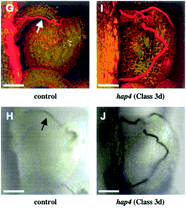Arabidopsis hapless Mutations Define Essential Gametophytic Functions
.
Mark A. Johnson, Kiera von Besser, Qing Zhou, EvadneSmith, George Aux, David Patton, Joshua Z. Levin, and
Daphne Preuss
* Howard Hughes Medical Institute, Department of Molecular Genetics and Cell Biology, The University of Chicago, Chicago, Illinois 60637.
Genetics, Vol. 168, 971-982, October 2004
.

Abstract: In flowering plants, the egg develops within a haploid embryo sac (female gametophyte) that is encased within the pistil. The haploid pollen grain (male gametophyte) extends a pollen tube that carries two sperm cells within its cytoplasm to the embryo sac. This feat requires rapid, precisely guided, and highly polarized growth through, between, and on the surface of the cells of the stigma, style, and ovary. Pollen tube migration depends on a series of long-range signals from diploid female cells as well as a short-range attractant emitted by the embryo sac that guides the final stage of tube growth. We developed a genetic screen in Arabidopsis thaliana that tags mutant pollen with a cell-autonomous marker carried on an insertion element. We found 32 haploid-disrupting (hapless) mutations that define genes required for pollen grain development, pollen tube growth in the stigma and style, or pollen tube growth and guidance in the ovary. We also identified genomic DNA flanking the insertion element for eleven hap mutants and showed that hap1 disrupts AtMago, a gene whose ortholog is important for Drosophila cell polarity.
-----------------------------------------------------------------------------
Click here for previously featured paper of the month.
|